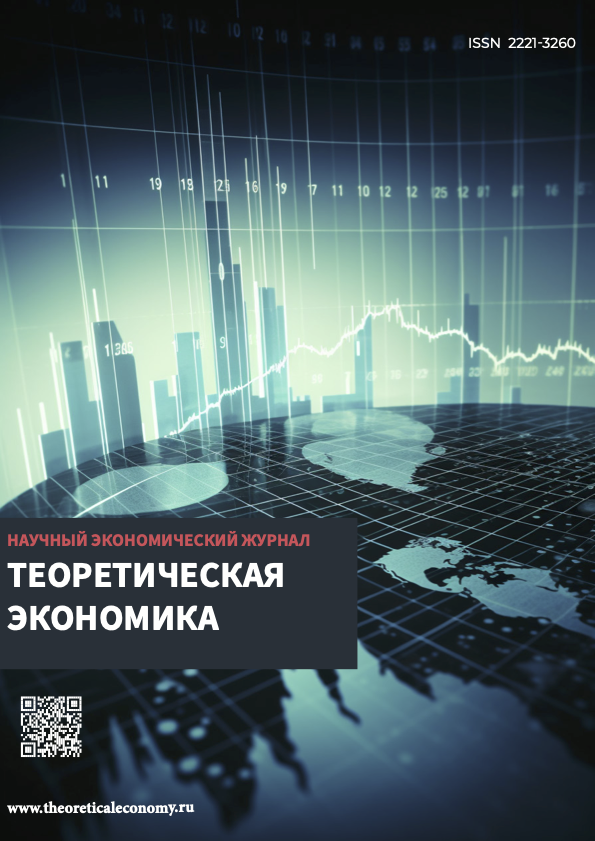Moscow, Moscow, Russian Federation
This article examines the thesis that macroeconomic models in countries that have achieved high rates of sustainable growth are characterized by dynamic and complex innovations and "creative destruction", export industries, as well as a high level of competition. In other words, dynamism, as the driving force of the economy, is also important for inclusivity, not just for growth and efficiency. These features are important for solving the problem of inequality (uneven distribution) of income in the market, that is, the initial distribution, as opposed to redistribution, which is usually the focus of the macroeconomic theory of inclusive growth. The article emphasizes that the dynamism of fair and inclusive markets is a key factor for achieving high sustainable and inclusive growth. The scientific novelty of the article consists in the study of various models of economic growth and the identification of individual macroeconomic elements of the dynamic relationship of the inclusive model of economic growth and innovation policy. In particular, the "Asian miracle" model of economic growth contains useful lessons not only for maintaining high and sustainable growth rates, but also for achieving inclusive growth. It is observed that the pioneers of the "Asian miracle" model of economic growth — Hong Kong, Japan, Korea, Singapore and Taiwan Province of China — have achieved sustained high growth for decades and have moved relatively quickly from low or middle income to high. Meanwhile, they have also witnessed a relatively less uneven distribution of market income. Their experience shows that state intervention leading to the creation of technologies, innovations and "creative destruction" in combination with competition in complex export markets may be necessary. Dynamism may be the key to inclusive growth, but at the same time, the growth of large firms, while important, could potentially lead to increased market power.
macroeconomic theory, economic growth, innovation policy, dynamics, inclusive growth
1. Abramov, R. Diversifikaciya ekonomiki regionov na osnove innovacionnogo razvitiya / Ruslan Abramov. - M.: LAP Lambert Academic Publishing, 2017. - 228 c.
2. Aktual'nye problemy Evropy. Evropa i Rossiya. Innovacionnoe razvitie i modernizaciya ekonomik. - M.: INION RAN, №1. 254 c. 2018
3. Aktual'nye problemy Evropy. Vypusk №1(2013). Evropa i Rossiya. Innovacionnoe razvitie i modernizaciya ekonomik: monogr. - M.: Institut nauchnoy informacii po obschestvennym naukam (INION) RAN, 2016. - 900 c.
4. Akulova, E. Innovacionnye resheniya na puti k effektivnomu razvitiyu ekonomiki Rossii / Ekaterina Akulova. - M.: LAP Lambert Academic Publishing, 2014. - 680 c.
5. Barrios, C., Flores, E., Martínez, M.A. Club convergence in innovation activity across European regions. Pap. Reg. Sci. 98 (4), 1545–1565. 2019
6. Asanov, A. Innovacionnaya sistema upravleniya ekonomikoy regiona / Aleksandr Asanov. - M.: LAP Lambert Academic Publishing, 2016. - 180 c.
7. Auzan, A.A. Innovacionnoe razvitie ekonomiki Rossii. Mezhdisciplinarnoe vzaimodeystvie. Sbornik statey / A.A. Auzan. - M.: Prospekt, 2016. - 646 c.
8. Matrizaev B.D. Issledovanie otlichitel'nyh osobennostey rezhimov biznes-innovaciy i ih vliyaniya na rezul'taty innovacionnoy deyatel'nosti makroregionov // Voprosy innovacionnoy ekonomiki. – 2020. – Tom 10. – № 4. – S. 2021-2036. – doi:https://doi.org/10.18334/vinec.10.4.110880.
9. Matrizaev B.D. Issledovanie osobennostey prociklicheskoy dinamiki investiciy v nauchno-tehnologicheskoe i innovacionnoe razvitie ekonomiki na primere stran s "dogonyayuschey" model'yu. Voprosy innovacionnoy ekonomiki. T. 9. № 3. S. 693-708. 2019.
10. Matrizaev B.D. Issledovanie gipoteticheskih osnov strategii tehnologicheskoy modernizacii i povysheniya innovacionnogo potenciala v stranah s bystrorastuschey ekonomikoy. Ekonomika: teoriya i praktika. № 1 (53). S. 15-21. 2019.
11. Baburin, V. L. Innovacionnye cikly v rossiyskoy ekonomike / V.L. Baburin. - Moskva: RGGU, 2014. - 120 c.
12. Bazilevich, A.I. Innovacionnyy menedzhment i ekonomika organizaciy (predpriyatiy): praktikum. Grif UMO VUZov Rossii: monogr. / A.I. Bazilevich. - M.: Infra-M, Vuzovskiy uchebnik, 2016. - 669 c.
13. Borisov V.N. i dr., Modernizaciya promyshlennosti i razvitie vysokotehnologichnyh proizvodstv v kontekste «zelenogo rosta». Pod redakciey akademika Porfir'eva B.N. – M.: Nauchnyy konsul'tant, 2017. – 434 s.
14. Borisov V.N. i dr., Prognozirovanie innovacionnogo mashinostroeniya. M.: MAKS Press, 2015. –180s.
15. Borisov V.N. i dr. Innovacionno-tehnologicheskoe razvitie ekonomiki Rossii: problemy, faktory, strategii, prognozy. - M.: MAKS PRESS, 2005. - 591 s.
16. Bogatova, E.V. Innovacionnaya ekonomika. Monografiya / E.V. Bogatova. - M.: Rusayns, 2015. - 897 c.
17. Archibugi, D., Filippetti, A. Is the economic crisis impairing convergence in innovation performance across Europe? J. Common. Mark. Stud. 49, 1153–1182. 2011.
18. Bergek, A., Hekkert, M., Jacobsson, S., Markard, J., Sandén, B., Truffer, B., Technological innovation systems in contexts: conceptualizing contextual structures and interaction dynamics. Environ. Innov. Soc. Transit. 16, 51–64. 2015.
19. Charnes, A., Cooper, W.W., Rhodes, E. Measuring the efficiency of decision making units. Eur. J. Oper. Res. 2 (6), 429–444. 1978.
20. Club of Rome. The Limits to Growth: A Report for the Club of Rome’s Projecton the Predicament of Mankind. Universe Books, New York. 1972.
21. Disoska, E.M., Tevdovski, D., Toshevska-Trpchevska, K., Stojkoski, V. Evidence of innovation performance in the period of economic recovery in Europe. Innovat. Eur. J. Soc. Sci. Res. 33 (3), 280–295. 2018.
22. Edquist, C., Zabala-Iturriagagoitia, J.M., Barbero, J., Zofio, J.L. On the meaning of innovation performance: is the synthetic indicator of the Innovation Union Scoreboard flawed? Res. Eval. 27 (3), 196–211. 2018.
23. Enflo, K., Hjertstrand, P. Relative sources of European regional productivity convergence: a bootstrap frontier approach. Reg. Stud. 43, 643–659. 2009.
24. European innovation scoreboard. Available. http://ec.europa.eu/growth/industry/innovation/facts-figures/scoreboards_en. 2019.
25. Furman, J., Hayes, R. Catching up or standing still? National innovative productivity among ‘follower’ countries, 1978–1999. Res. Pol. 33, 1329–1354. 2004.
26. Leibenstein, H. X-efficiency: from concept to theory. Challenge 22 (4), 13–22. 1979.
27. Fagerberg, J. A technology gap approach to why growth rates differ. Res. Pol. 16, 87–94. 1987.
28. Rolf F. and Anders K.: Sten Malmquist In memoriam, Journal of Productivity Analysis Volume 23, Number 2 / May, 2005, p. 141-142
29. Shephard, R.W. Cost and Production Functions. Princeton University Press, Princeton. 1953.
 This work is licensed under Creative Commons Attribution-NonCommercial-NoDerivatives 4.0 International
This work is licensed under Creative Commons Attribution-NonCommercial-NoDerivatives 4.0 International












